Amphissa columbiana Dall, 1916Common name(s): Wrinkled amphissa, Wrinkled dove snail, Columbian amphissa |
|
| Synonyms: | 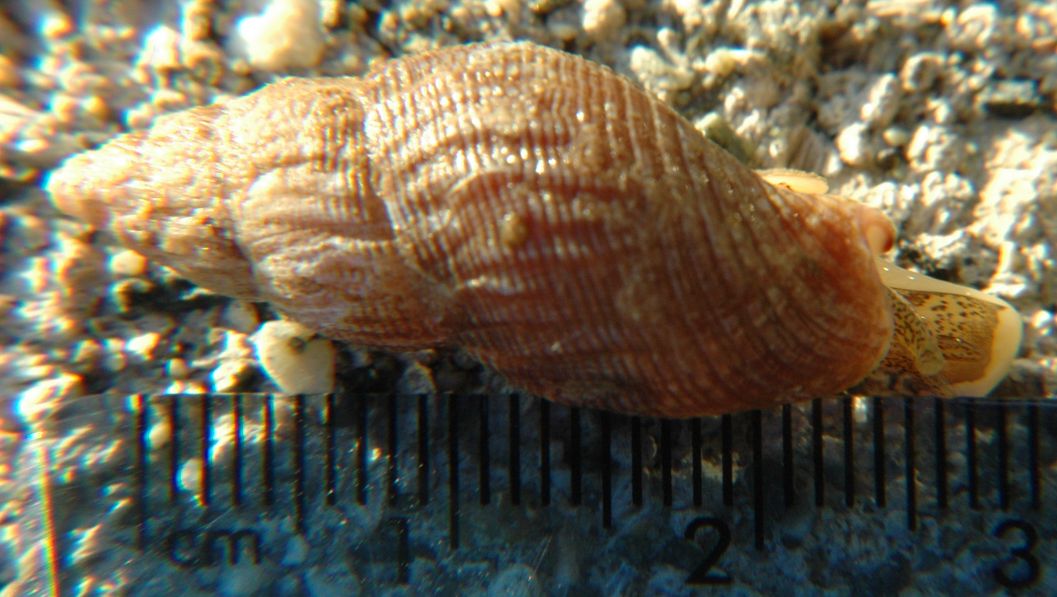 |
|
Subclass Prosobranchia
Order Neogastropoda
Suborder Rachiglossa
Family
Columbellidae
(Pyrenidae)
|
|
| Amphissa columbiana, 3 cm long, trawled from 120 m depth, San Juan Channel, WA | |
| (Photo by: Dave Cowles, July 2005) | |
How to Distinguish from Similar Species: Look carefully for the small folds on the columella as well as the outer lip of the aperture in order to key this species to the right family. Amphissa versicolor grows to only 1.5 cm and the axial ribs are angled instead of aligned with the length of the shell and it may have a pattern of light and dark markings. Amphissa reticulata, a rare subtidal species, has the middle third of the outer lip of the aperture rounded and also only gets to 1.5 cm long. In several other members of Family Columbellidae the spiral ridges are found only on the anterior portion of the body whorl.
Geographical Range: Kodiak Island, Alaska to San Pedro, California. Common in the Puget Sound area and the outer Northwest coast. In California A. versicolor is more common.
Depth Range: Intertidal to 29 m (But the individual above was trawled from a depth of 120 m in San Juan Channel).
Habitat: Rocky to muddy beaches and subtidally on many substrates.
Biology/Natural History: This species is mainly a scavenger on dead flesh and dead algae, which it uses its long siphon to find. It also has a very long proboscis, up to at least 2.5x its shell length (Braithwaite et al., 2017). It may be found in Enteroctopus dofleini middens consuming the scraps left from discarded octopus meals. It is a very active snail. Kent (1981) found that it turns and flees rapidly when it encounters the seastars Pisaster ochraceus or Leptasterias hexactis. If several tube feet have attached to the shell, the snail dislodges the tube feet with its proboscis. When moving, a single muscular wave moves along the snail's foot from front to back. They climb well, and often rear up on the back of the foot to feel for new substrate. A gland on the rear of the foot secretes a thick mucus strand which the animal can use to suspend itself in the water. Females attach vase-shaped capsules to rocks. Each capsule contains about 60 white eggs. The empty shells are often used by hermit crabs.
In his dissertation, Seavey (1977) reports that on the Oregon coast it takes approximately 16 months for eggs to mature in this species. Spermatogenesis occurs throughout the year. in males. Spawning begins in October and November in Oregon.
In a study on San Juan Island, Pernet (2007) found that different individuals of this species matured at very different sizes. Immature individuals were characterized by shells in which the outer aperture was thin and easily broken. These individuals were still growing. Mature individuals had outer apertures which were much thicker, and were growing little or not at all even if they were not as large as some other immature individuals which were still growing. Pernet concluded that this species has determinate growth. Exposure in the lab to effluent from Cancer productus did not affect the shell form or thickness, suggesting that the large range of sizes at maturity is not due to a response to predation by the crab.
Braithwaite
et al., (2017) determined through field observations and laboratory
tests that this species is primarily a scavenger on the soft, decaying
tissues of many different types of dead animals. It often
feeds in
aggregations, and follows mucus trails of other individuals. In lab
experiments it was not attracted to live tissue but was rapidly
attracted to dead, rotting tissue of a wide variety of species from up
to 1/2 m away. The only dead tissue tested that it was not attracted to
was that of the nemertean worm Tubulanus polymorphus.
The smell of decaying scallops stimulated the snails to extend their
long proboscis and feed on a nearby living scallop. In the field the
snails were often found aggregating under feeding seastars and feeding
on the prey the seastars were feeding on. These seastars included Leptasterias hexactis,
Orthasterias koehleri,
Pteraster tesselatus,
Solaster stimpsoni,
Solaster dawsoni,
and especially Evasterias troschelii.
| Return to: | |||
| Main Page | Alphabetic Index | Systematic Index | Glossary |
References:
Dichotomous Keys:Flora and Fairbanks, 1966
Kozloff 1987, 1996
Smith and Carlton, 1975
General References:
Harbo,
1997
Kozloff,
1993
Morris,
1966
Morris
et al., 1980
O'Clair
and O'Clair, 1998
Sept,
1999
Scientific Articles:
Braithwaite, Lee F., Anthony
Rodriguez-Vargas,
Miles Borgen, and Brian L. Bingham, 2017. Feeding behavior of the
wrinkled dove snail Amphissa columbiana. Northwest
Science 91:4 pp 356-366
Kent, Bretton W., 1981. Behavior of the gastropod Amphissa columbiana. Veliger 23: 275-276
Pernet, Bruno, 2007. Determinate growth and variable size at maturity in the marine gastropod Amphissa columbiana. American Malacological Bulletin 22: 7-15
Seavy, Donald K., 1977. Seasonal gametogenesis and egg laying in the prosobranch gastropods Nucella lamellosa, Nucella emarginata, Searlesia dira, and Amphissa columbiana on the Oregon coast. Ph.D. dissertation, Oregon State University. 179 pp. (As N. emarginata)
Web sites:
General Notes and Observations: Locations, abundances, unusual behaviors:
I do not find these often near Rosario but they are more common in deep trawls here and on the outer coast.
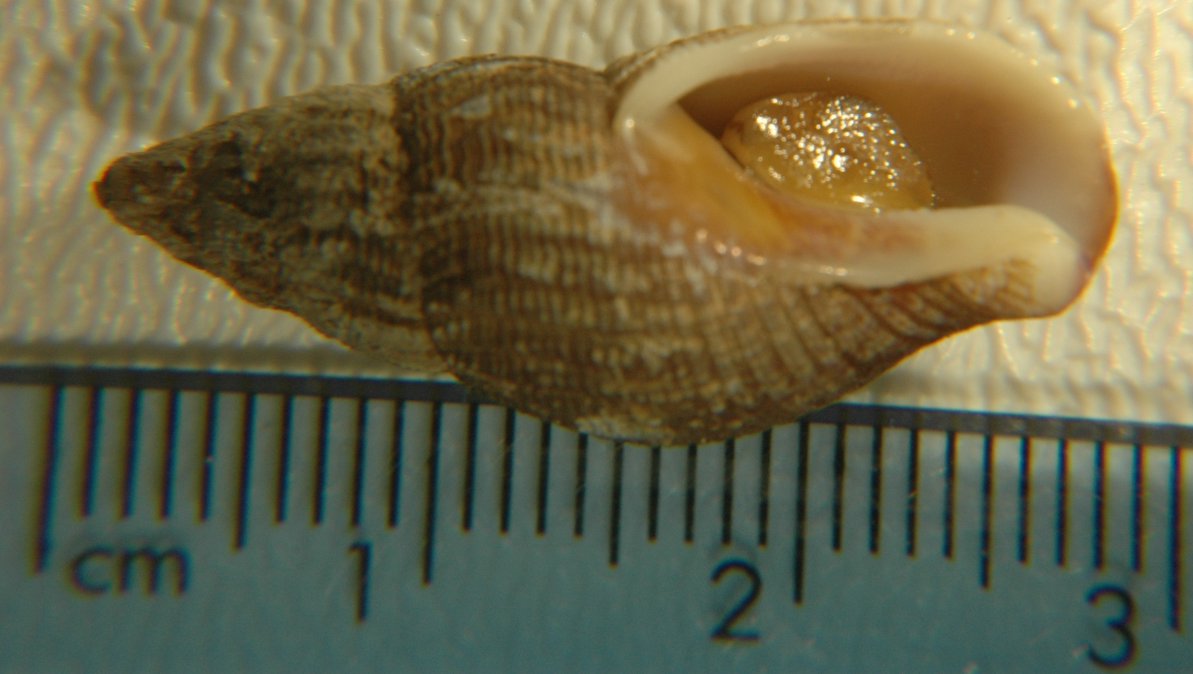
In this photo the shape of the aperture,
the siphonal
notch, and the uncalcified operculum
can be seen. Trawled from 120 m depth in San Juan Channel.
According to the criteria in Pernet (2007) I would conclude
that
this individual is sexually mature due to the thick outer lip of the
aperture.
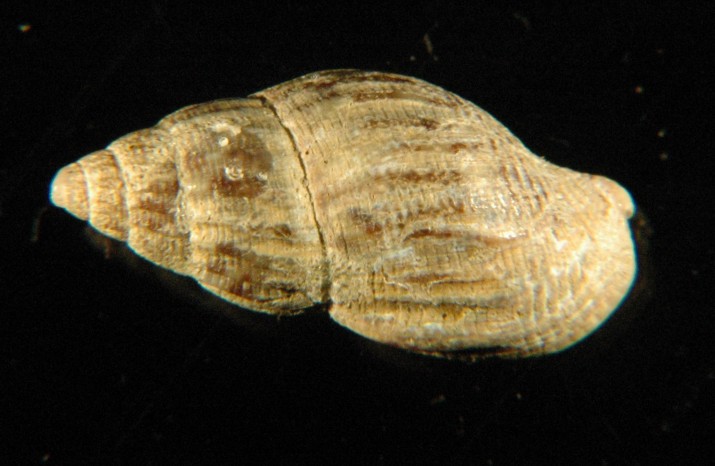 |
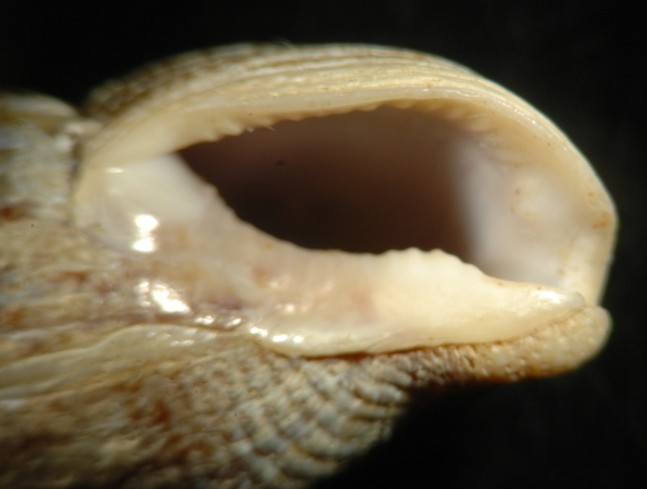 |
| In these photos of an individual found washed up on Hobuck Beach, near Neah Bay on the open coast, the folds can be seen both on the columella and on the outer lip of the aperture. This individual is 3 cm long. | |
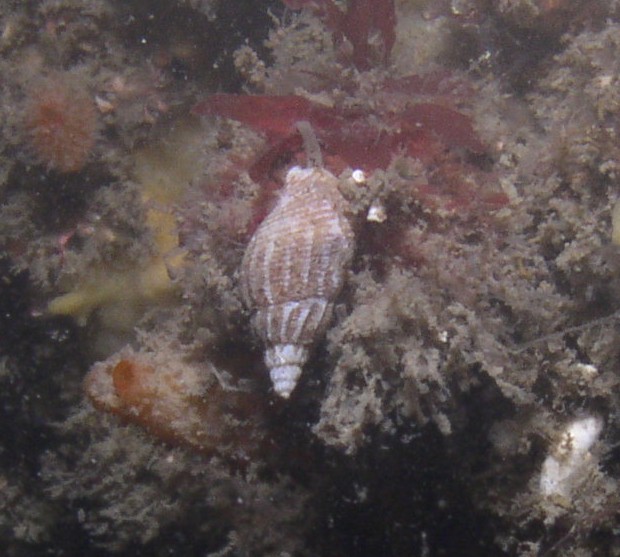
An individual climbs a rock face underwater.
Photo by Kirt Onthank, June 2007
Authors and Editors of Page:
Dave Cowles (2007): Created original page
Jonathan Cowles (2007): Updated page with CSS